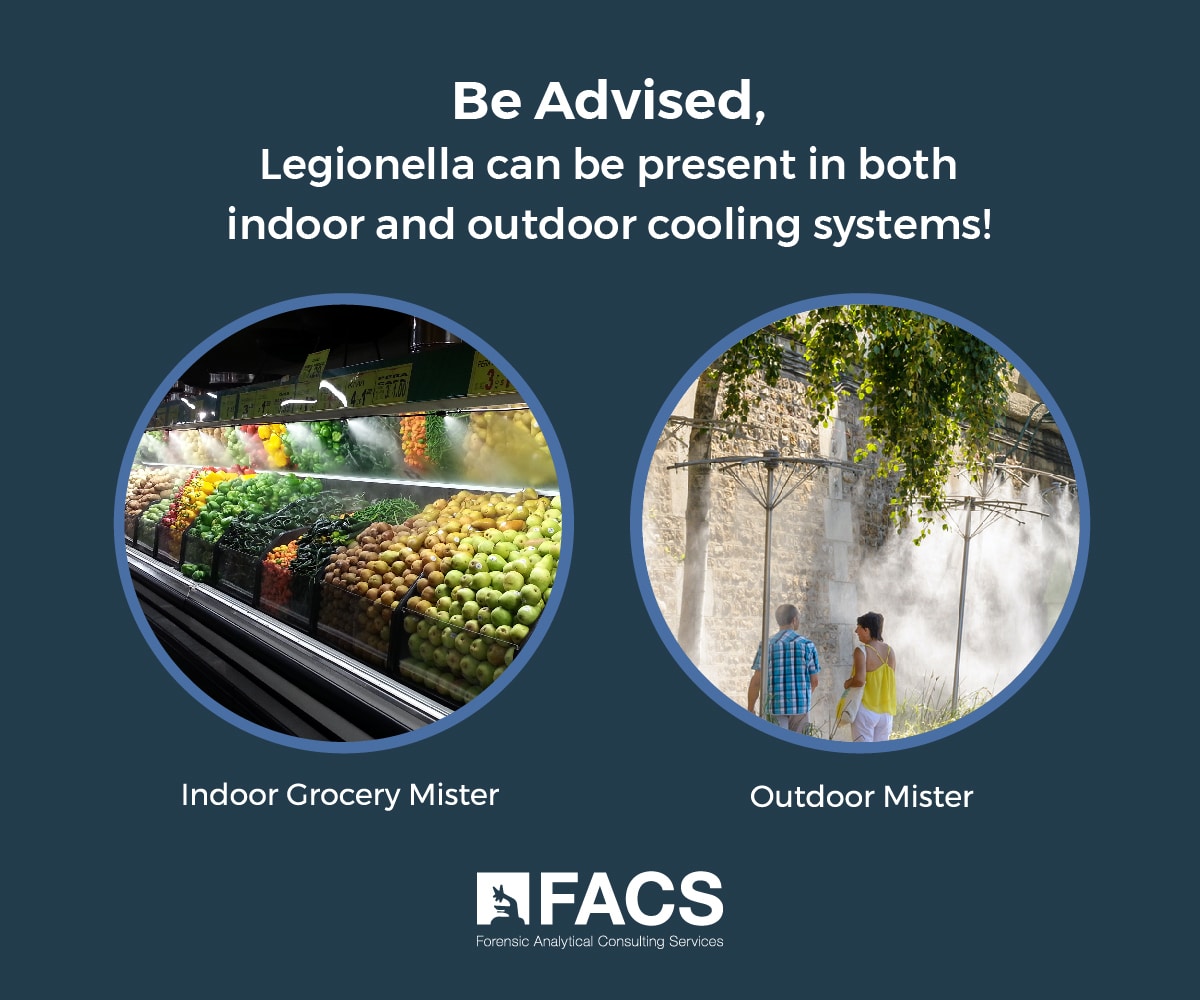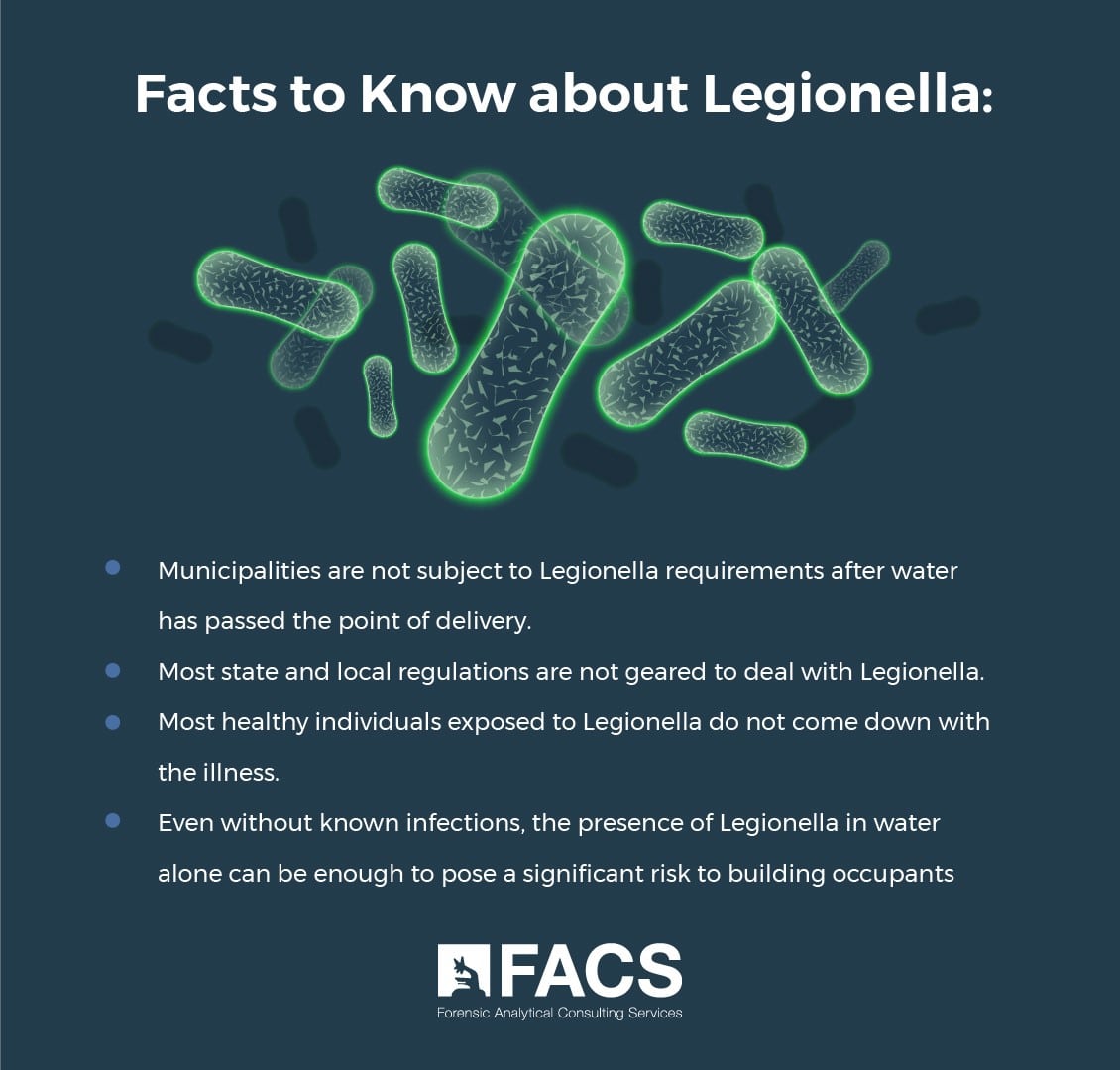Legionella & Legionnaires’ Disease are environmental health issues that FACS experts often receive questions about. Given that Legionella was discovered less than 50 years ago and is a relatively “young” subject among environmental health issues, there are lots of questions to be asked.
On March 5th, 2019, FACS’ Legionella Expert Megan Canright, MPH, CIH, partnered with the TASA Group to host a webinar on the introduction to Legionella. While TASA’s audience is primarily attorneys, this webinar covered many of the basic principles around Legionella and provided information useful to many.
FACS received many questions about Legionella & Legionnaires’ Disease following the webinar, many of which are asked frequently. We’ve aggregated the questions & answers from this webinar below, and we hope you find them useful whether you’re an attorney, a building maintenance manager, or have been affected by the disease.
If you’re in the beginning stages of learning about Legionella & Legionnaires’ Disease and want to learn more about the “basics” before diving into the questions below, see our introductory blog on Legionella & Legionnaires Disease here.
How seriously are the suggested guidelines (ASHRAE Standard 188) taken by municipalities?
Municipalities are only responsible for water provided to the point of delivery to a property (typically, at the backflow preventer) and have no responsibility or jurisdiction over water supplied after the point of delivery. Municipalities are therefore not subject to the recommendations and requirements outlined in the Legionella standards and guidelines available in the United States. Hospitals, critical access hospitals (CAHs), and long-term care facilities (LTC) are required by a mandate, released by the Centers for Medicare and Medicaid Services (CMS) in 2017 and revised in 2018, to implement water management practices that consider the ASHRAE 188 voluntary standard and CDC guidelines.
These standards and guidelines are also becoming more visible in other industries. In addition to healthcare regulators, the standards and guidelines are being referenced by Departments of Health, building code enforcement, etc. While the enforcement cannot be categorized as “rigorous” at this point, these documents are being more frequently referenced as the “standards of care”. The ASHRAE 188 standard is quite comprehensive, often requiring a significant amount of resources, personnel hours, and funding; therefore, implementation at the building level outside of healthcare varies from non-compliance to stages of partial compliance and full compliance. Certainly, reference to these documents by regulators becomes more rigorous for a facility where potential epidemiological links to building-associated cases have been identified.
Can Legionnaires Disease be acquired from an area that has outdoor water misters that are used to cool outdoor areas, such as dining?
Any aerosol-generating source can potentially be considered at-risk. Both outdoor misters and indoor misters (e.g., grocery stores) have been associated with known Legionella-associated disease cases, however, their association with known outbreaks is rare.

Are there any implications for residential heating/cooling systems?
The primary risks associated with HVAC systems are cooling towers, which are generally associated with large scale cooling systems. Cooling towers are not present in single-family residential homes but are often present in multi-unit buildings. There is some speculation that standing water in condensate pans and other chilled components of HVAC systems where condensation can occur could harbor Legionella bacteria. These conditions would generally be too cold for Legionella to amplify and thus are an unlikely source. Potable water (including pools/spas and decorative fountains or irrigation systems) can be a risk for amplification in any building, including residential settings.
Is it possible to determine if you’ve had Legionella in the past?
The presence of the Legionella antigen in urine samples or seroconversion can be used to determine whether a person has been recently exposed to Legionella bacteria. Not all persons who are exposed to Legionella acquire a Legionella-associated illness. Public exposure to Legionella can occur in a variety of environments and it is anticipated that most people will have been exposed to Legionella in their lifetime. The CDC states that most healthy individuals who are exposed to Legionella bacteria do not come down with the illness. There is also some evidence to support that persons who have previously been diagnosed with Legionnaires Disease develop immunity and are protected against future infection.
What are the typical methods of testing the water systems, potable and non-potable?
Sampling methods for Legionella bacteria include culture, PCR, and other proprietary and rapid-detection methods. Surrogate parameters (heterotrophic bacteria, free oxidant, temperature, etc.) have been used by some professionals to attempt to circumvent the need to sample for Legionella bacteria. While some of these parameters may provide useful information regarding risk, only sampling for the bacteria itself is a true indicator of its presence or absence. Sampling for Legionella should only be performed by a competent professional who is well-versed in the sampling and analytical methods and understands the limitations of these methods. Viable culture is the recommended or “gold standard” sampling method for outbreak or case investigation situations. The sampling methods are generally the same for all water system types, but there are differences in the way samples are analyzed based on source type (potable, non-potable, etc.)
Regarding when to sample water, the New York State and New York City rules seem to differ from the industry voluntary standards, which seem to say don’t just sample routinely. Is this correct?
The New York State and New York City regulations require routine sampling for Legionella bacteria in cooling towers. Some of the guidance documents, such as the AIHA guide, point to routine sampling as a method to validate controls implemented as part of a robust water management plan. Other guidance documents state that sampling should only be performed for a specific purpose, such as when cases have been identified. The ASHRAE and CDC guidance documents have not taken a firm stance on recommending sampling. The only validated method for determining the presence of Legionella in water systems is to sample directly for the bacteria.

Is there a link between oxidation chemistry levels and Legionella bacteria concentration? Can biofilm be measured to reduce Legionnaires’ Disease?
Oxidants have varying efficacy against Legionella and other bacteria; efficacy is dependant on a variety of environmental factors including pH, free oxidant concentration, bacteria concentration, whether bacteria are sessile (in a biofilm) or planktonic (free-floating), the presence of organic material and water quality, and many other factors. Recommendations have been made by regulatory and guidance documents regarding appropriate maintenance of oxidant and other water quality parameters for the control of Legionella. Biofilm can be evaluated and measured in a laboratory setting, but there is no current field test that is feasible for evaluating biofilm conditions.
Is EPA developing regulations?
EPA has already published documents related to Legionella. The most recent publication is the “Technologies for Legionella Control in Premise Plumbing Systems” document. EPA is also considering adding a requirement regarding municipal responsibility for delivery of a specified level of residual disinfectant from the municipal treatment process. Currently, most municipalities are only required to deliver “detectable” concentrations of residual oxidant, which is typically interpreted as greater than 0.2 ppm free chlorine.
What combination of retained experts do you usually see for a Plaintiff’s case? Is an industrial hygienist paired with a medical doctor typical, or are there usually additional experts?
The experts designated on a particular case may vary depending on the needs of the case. For both the plaintiff and defense, examples of experts that might be designated include: industrial hygienists, epidemiologists, toxicologists, occupational and environmental physicians, mechanical and plumbing professionals or engineers, architects, infection preventionists, etc.
By the time an attorney gets involved on behalf of someone who becomes ill, it may be too late to do their own investigation. What records can they rely upon?
There are many records that can be reviewed as part of a Legionella risk assessment and investigation. The retained expert can provide consultation regarding records related to potential sources or risks specific to the case. Examples of these records may include: building maintenance records, water management plans, temperature and oxidant records, flushing records, pool and spa maintenance and testing records, mechanical/plumbing plans and as-buildings, etc.
Does compliance with the State’s rules and regulations regarding public pools and spas constitute compliance with the relevant standard of care?
Unfortunately, most state and local regulations regarding public pools and spas are geared toward the prevention of public health concerns (E. coli, Cryptosporidium, Giardia, etc.) other than Legionella. These regulations can vary from state to state and county to county, but typically revolve around maintenance of oxidant, pH, and stabilizer chemicals to provide appropriate disinfection along with regular testing. While these regulations certainly help to control Legionella, the available guidance documents that specifically target Legionella control tend to recommend more comprehensive management controls for prevention of Legionella bacteria specifically.
How are environmental samples utilized to support patient infection and demonstrate liability?
Biological samples, such as blood, urine, and sputum samples, collected from patients who are diagnosed with Legionnaires’ Disease can be compared to environmental samples (water, swab, bulk) collected from water sources to which the patient may have been exposed. These patient samples can be compared to the environmental samples using a variety of testing methods including species identification, serogroup identification, partial or whole genome sequencing, etc. In FACS’ experience, a match between these samples is not necessary to establish liability. The presence of Legionella bacteria in water sources, conditions conducive to the growth of Legionella, and generally poor water management practices alone can be enough to claim causation. Detection of the same species and serogroup of Legionella that caused infection (“outbreak strain”) in the environment at levels indicative of amplification can demonstrate causation. Similarly, the absence of the “outbreak strain” in other sources of exposure during the potential exposure period can also support the causation argument. Many factors must be considered when determining the “probability of causation”.
Have a question about Legionella or Legionnaires Disease that wasn’t answered above? Contact us or give us a call at (888) 711-9998 and we’ll put you in touch with one of our Legionella Experts.